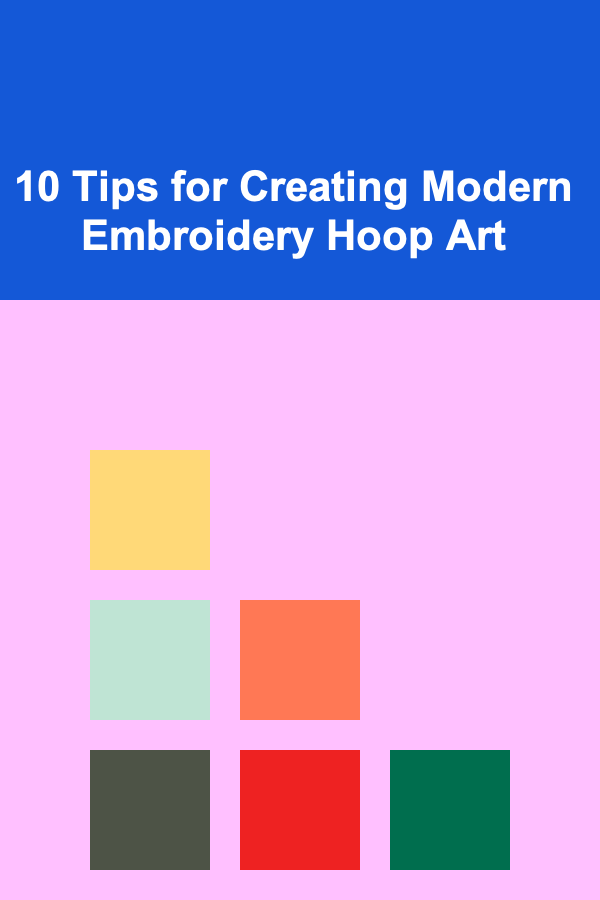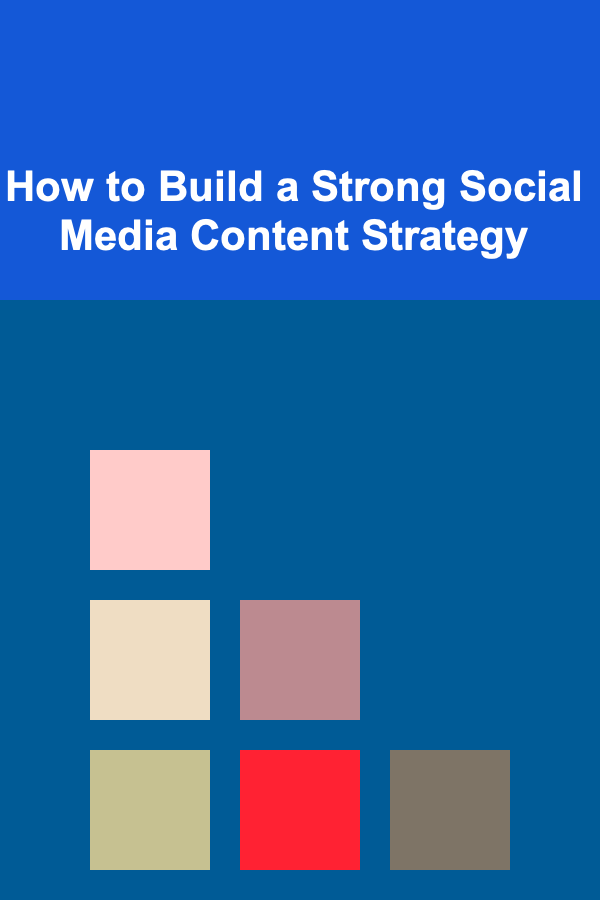
10 Tips for Creating Modern Embroidery Hoop Art
ebook include PDF & Audio bundle (Micro Guide)
$12.99$6.99
Limited Time Offer! Order within the next:

Embroidery has experienced a resurgence in recent years, evolving from a traditional craft into a modern form of art. No longer confined to the vintage designs or heirloom pieces that were once typical, modern embroidery hoop art embraces bold colors, unique patterns, and even mixed media techniques. This creative outlet allows artists to personalize their pieces with intricate stitching while experimenting with new design trends. Whether you're an experienced embroiderer or a beginner just getting started, this guide will provide you with 10 essential tips for creating stunning modern embroidery hoop art that reflects your personality and style.
Choose the Right Hoop and Fabric
The first step to creating your embroidery hoop art is selecting the right tools, particularly the hoop and fabric. The size of the hoop can significantly affect the overall feel of the final piece, and the fabric will serve as the canvas for your design.
Hoop Size:
While traditional embroidery often uses smaller hoops, modern embroidery can utilize hoops of various sizes. Larger hoops allow for more expansive designs and can be great for creating intricate, free-flowing patterns. Smaller hoops, on the other hand, are ideal for focusing on detail and creating miniature artworks.
Fabric Choices:
For modern embroidery, you can break free from the traditional plain muslin or linen fabrics. Popular choices for contemporary hoop art include:
- Cotton canvas for a sturdy, neutral background.
- Velvet or felt for a luxurious, textured surface.
- Printed fabrics like floral or geometric patterns can add depth and interest to your work.
- Denim or linen for a more rustic, organic feel.
Choose a fabric that complements your design concept and stitching style. Remember, the fabric should be sturdy enough to handle the stitching but flexible enough to fit the hoop without wrinkling.
Experiment with Color Palettes
Color plays a crucial role in modern embroidery, and selecting the right palette is essential for making your artwork stand out. The current trend in modern embroidery leans toward bold, vibrant colors, minimalistic palettes, or even monochromatic schemes.
Bold Color Combinations:
Bright, contrasting colors can make your design pop and create a sense of excitement. Think of pairing neon threads with dark backgrounds or using complementary colors to create a dynamic effect.
Minimalist or Muted Palettes:
For a more sophisticated, understated look, consider using a minimalist palette with muted or neutral tones. This approach often includes subtle color shifts and more delicate stitching, allowing the textures and patterns to shine through without overwhelming the viewer.
Textured Threads:
Experiment with different types of threads to create texture and depth. Consider using metallic threads, variegated floss, or even yarn for a more tactile design. These choices can add visual interest while maintaining a clean, modern aesthetic.
Incorporate Abstract Designs
Modern embroidery frequently moves away from traditional motifs like flowers and animals in favor of abstract designs. These can range from geometric shapes and lines to free-form, organic patterns. Abstract embroidery allows you to play with the composition and scale of the design, making it highly customizable and personal.
Geometric Shapes:
Simple shapes such as triangles, circles, or squares arranged in interesting patterns are common in modern embroidery. Use contrasting colors and lines to create a sense of movement or symmetry.
Freeform Lines:
Freehand stitching or freeform embroidery can give your work an organic, fluid quality. These kinds of designs are ideal for showcasing the beauty of individual stitches, like straight stitches, satin stitches, and French knots, which can flow into one another to create textured, dynamic designs.
Layering and Textures for Depth
One of the hallmarks of modern embroidery is the use of texture and layering to create depth and dimension. By combining different embroidery techniques and materials, you can create designs that seem to pop off the fabric.
Layering Stitches:
Layering stitches can help create intricate designs. For example, you can stitch a base layer of long stitches and then overlay a second layer of short, dense stitches for added texture. Alternatively, you can combine different types of stitches (e.g., chain stitch, French knots, or satin stitch) to create visually striking contrasts.
Mixed Media Embroidery:
Incorporating other media into your embroidery is an excellent way to make it stand out. Consider adding beads, sequins, or ribbons to your design for added texture. You can also experiment with fabric manipulation techniques like pleating or gathering to create 3D effects.
Create a Focal Point
Like any form of art, your embroidery hoop design should have a clear focal point. The focal point draws the viewer's eye and gives the piece balance. Whether it's a specific stitch, a bold color, or an intricate design element, having a defined center will help your piece feel cohesive and intentional.
Emphasize the Focal Point:
You can emphasize the focal point by using a contrasting color, larger stitches, or by surrounding it with simpler or lighter stitching. For example, if your design features a geometric shape, you might use a contrasting thread color to make the shape stand out from the background.
Incorporate Hand-Drawn Elements
Modern embroidery allows you to break the boundaries of traditional patterns by incorporating hand-drawn elements. Sketching out your design before stitching it allows for more free-form creativity and a unique, artistic feel.
Draw Your Own Designs:
Start by sketching your ideas directly onto the fabric with a disappearing ink pen or chalk. This gives you the freedom to create abstract lines, portraits, or any kind of design that would be challenging with pre-made patterns. If you're unsure about your drawing skills, start with simple shapes or inspirational doodles.
Mixed Techniques:
You can combine hand-drawing and embroidery for an even more contemporary effect. For example, you could stitch over your hand-drawn lines, blending the two mediums. This results in a fusion of illustration and textile art.
Explore Negative Space
Modern embroidery isn't just about what you stitch, but also about what you don't stitch. Negative space refers to the blank or unstitched areas of your piece, and it can be just as important as the areas you fill with thread.
Let the Fabric Show:
Instead of filling every inch of the fabric with stitching, allow some areas to remain bare. This will create contrast and highlight the intricacy of the stitches that you do add. Negative space is often used in minimalist designs to create a sense of balance and harmony.
Creative Framing:
Another way to play with negative space is by leaving gaps around the edge of the hoop. Instead of filling in the entire hoop, consider leaving some of the fabric exposed to create an airy, open feel. This technique is especially effective for larger designs or more abstract pieces.
Mix Traditional and Modern Stitches
While modern embroidery often embraces contemporary design elements, traditional stitches still play a vital role. Blending old and new techniques can add interest to your work and help maintain a connection to the craft's rich history.
Traditional Stitches with a Twist:
Try combining classic stitches like French knots, backstitch, and satin stitch with modern techniques like thread painting or contemporary quilting techniques. Mixing these elements can help you create a more dynamic design and can make your piece feel timeless.
Use Your Embroidery as Wall Art
Modern embroidery is perfect for framing and displaying as wall art. When you treat your hoop art as a standalone piece of décor, it transforms from a simple craft project into a statement art piece that adds personality to any space.
Consider Frame Placement:
When choosing a frame or the style of hoop, think about where your embroidery will hang. Larger hoops can work well for bold, statement designs, while smaller hoops can be grouped together to create a gallery wall effect.
Add Custom Touches:
You can also experiment with framing your hoop art in unconventional ways. For example, try displaying it in a shadow box, pairing it with other materials, or mounting it to a piece of driftwood for a natural touch.
Have Fun and Be Creative
Above all, the key to modern embroidery hoop art is creativity. Don't be afraid to break the rules or try something new. Embroidery is a personal and expressive art form that allows you to experiment with different techniques, materials, and designs until you find your unique style.
Play with Color, Texture, and Shape:
Challenge yourself to create something unexpected. Experiment with different types of fabric, thread, and even additional embellishments like beads or fabric paints. The more you practice, the more confident you'll become in your ability to push the boundaries of what embroidery can be.
Conclusion
Creating modern embroidery hoop art is a beautiful way to express your creativity and personal style. With the right tools, techniques, and mindset, you can craft intricate, one-of-a-kind pieces that transform any space into an artistic expression of your personality. Whether you're using bold color combinations, experimenting with textures, or incorporating abstract designs, there's no limit to the possibilities in modern embroidery. By following these 10 tips, you'll be well on your way to creating stunning embroidery hoop art that is as contemporary as it is timeless.
Reading More From Our Other Websites
- [Sewing Tip 101] Fabric Swap Challenge: Designing with Materials You've Never Used Before
- [Organization Tip 101] Step-by-Step Smart Thermostat Installation Guide for Beginners
- [Home Soundproofing 101] How to Reduce Noise in Your Basement with Effective Ceiling Soundproofing
- [Biking 101] Top 5 Must-Have Bike Accessories for Every Cyclist
- [Home Staging 101] How to Stage Your Home's Basement to Maximize Its Potential
- [Home Pet Care 101] How to Choose Pet-Safe Cleaning Products for Your Home
- [Home Renovating 101] How to Transform Your Basement Into a Functional Living Space
- [Organization Tip 101] How to Create a Home Gym Space in Your Garage
- [Tiny Home Living Tip 101] Best Compact Appliance Sets for Tiny Home Kitchens That Deliver Restaurant‑Quality Results
- [Organization Tip 101] How to Create a Budget for Home Renovations

10 Affordable Options for Pet Grooming and Vet Care You Can Trust
Read More
Optimizing Processes: Innovative Strategies for Successful Operations Coordination
Read More
The Impact of Continuing Education on Your Job Search
Read More
Why Every Room Needs a Purpose for Effective Organization
Read More
How to Diversify Your POD Product Offerings
Read More
How to Build a Strong Social Media Content Strategy
Read MoreOther Products

10 Affordable Options for Pet Grooming and Vet Care You Can Trust
Read More
Optimizing Processes: Innovative Strategies for Successful Operations Coordination
Read More
The Impact of Continuing Education on Your Job Search
Read More
Why Every Room Needs a Purpose for Effective Organization
Read More
How to Diversify Your POD Product Offerings
Read More